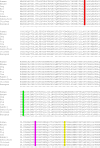De novo missense variants in PPP1CB are associated with intellectual disability and congenital heart disease
- PMID: 27681385
- PMCID: PMC5663278
- DOI: 10.1007/s00439-016-1731-1
De novo missense variants in PPP1CB are associated with intellectual disability and congenital heart disease
Abstract
Intellectual disabilities are genetically heterogeneous and can be associated with congenital anomalies. Using whole-exome sequencing (WES), we identified five different de novo missense variants in the protein phosphatase-1 catalytic subunit beta (PPP1CB) gene in eight unrelated individuals who share an overlapping phenotype of dysmorphic features, macrocephaly, developmental delay or intellectual disability (ID), congenital heart disease, short stature, and skeletal and connective tissue abnormalities. Protein phosphatase-1 (PP1) is a serine/threonine-specific protein phosphatase involved in the dephosphorylation of a variety of proteins. The PPP1CB gene encodes a PP1 subunit that regulates the level of protein phosphorylation. All five altered amino acids we observed are highly conserved among the PP1 subunit family, and all are predicted to disrupt PP1 subunit binding and impair dephosphorylation. Our data suggest that our heterozygous de novo PPP1CB pathogenic variants are associated with syndromic intellectual disability.
Conflict of interest statement
The other authors declare that they have no conflict of interest.
Figures





References
-
- Aggen JB, Nairn AC, Chamberlin R. Regulation of protein phosphatase-1. Chem Biol. 2000;7(1):R13–R23. - PubMed
-
- Ansai T, Dupuy LC, Barik S. Interactions between a minimal protein serine/threonine phosphatase and its phosphopeptide substrate sequence. J Biol Chem. 1996;271(40):24401–24407. - PubMed
-
- Barker HM, Brewis ND, Street AJ, Spurr NK, Cohen PT. Three genes for protein phosphatase 1 map to different human chromosomes: sequence, expression and gene localisation of protein serine/threonine phosphatase 1 beta (PPP1CB) Biochim Biophys Acta. 1994;1220(2):212–218. - PubMed
-
- Bausen M, Weltzien F, Betz H, O’Sullivan GA. Regulation of postsynaptic gephyrin cluster size by protein phosphatase 1. Mol Cell Neurosci. 2010;44:201–209. - PubMed
Publication types
MeSH terms
Substances
Grants and funding
LinkOut - more resources
Full Text Sources
Other Literature Sources
Medical
Molecular Biology Databases

